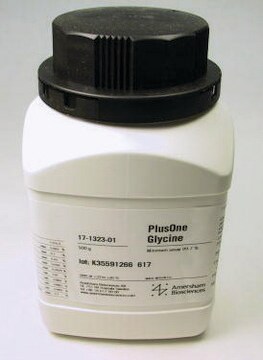Key Documents
G7126
Glycine
≥99% (HPLC), suitable for western blotting, ReagentPlus®
Synonim(y):
Aminoacetic acid, Aminoethanoic acid, Glycocoll
About This Item
Polecane produkty
product name
Glycine, ReagentPlus®, ≥99% (HPLC)
Poziom jakości
linia produktu
ReagentPlus®
Próba
≥99% (HPLC)
Postać
powder
metody
western blot: suitable
zanieczyszczenia
≤0.01% Ammonia
strata
≤0.2% loss on drying
kolor
white to off-white
pKa (25°C)
(1) 2.35, (2) 9.60
2.35
mp
240 °C (dec.) (lit.)
rozpuszczalność
H2O: 200 mg/mL, clear, colorless to faintly yellow
ślady kationów
≤0.01% (Ammonia (NH3))
grupa funkcyjna
amine
carboxylic acid
temp. przechowywania
room temp
ciąg SMILES
NCC(O)=O
InChI
1S/C2H5NO2/c3-1-2(4)5/h1,3H2,(H,4,5)
Klucz InChI
DHMQDGOQFOQNFH-UHFFFAOYSA-N
informacje o genach
rat ... Grin2a(24409)
Szukasz podobnych produktów? Odwiedź Przewodnik dotyczący porównywania produktów
Opis ogólny
Beyond its vital biological functions, glycine demonstrates remarkable versatility in various research applications. Its application as a biochemical reagent makes it invaluable in numerous assays and procedures. Its buffering capacity allows it to play a critical role in protein analysis techniques like SDS-PAGE and Western Blotting, chromatography, and cell culture. Glycine′s zwitterionic nature makes it an effective buffer across a range of pH values. In immunology research, it is widely used in the preparation of buffers for Western Blotting and other techniques. Additionally, its compatibility with various enzymes makes it useful in enzymatic assays like lactate determination. Furthermore, glycine contributes to the formulation of buffers for protein stabilization, pH control, and enzymatic reactions.
Zastosowanie
- Glycine has been added in the transfer buffer during western blotting procedure.
- It has been used in the solution prepared for dissolving formazan crystals in the MTT (3-[4,5-dimethylthiazol-2-yl]-2,5 diphenyltetrazolium bromide) cytotoxicity assay.
- It has been used for terminating the rat basophilic leukemia (RBL) assay.
Działania biochem./fizjol.
Cechy i korzyści
- Suitable for Cell Biology and Biochemical research
- High-quality compound suitable for multiple research applications
Inne uwagi
Informacje prawne
produkt podobny
produkt powiązany
Kod klasy składowania
11 - Combustible Solids
Klasa zagrożenia wodnego (WGK)
WGK 1
Temperatura zapłonu (°F)
Not applicable
Temperatura zapłonu (°C)
Not applicable
Środki ochrony indywidualnej
Eyeshields, Gloves, type N95 (US)
Certyfikaty analizy (CoA)
Poszukaj Certyfikaty analizy (CoA), wpisując numer partii/serii produktów. Numery serii i partii można znaleźć na etykiecie produktu po słowach „seria” lub „partia”.
Masz już ten produkt?
Dokumenty związane z niedawno zakupionymi produktami zostały zamieszczone w Bibliotece dokumentów.
Klienci oglądali również te produkty
Produkty
Neoplastic cells are highly dependent on the de novo synthesis of nucleotides to maintain sufficient pools to support DNA replication and the production of RNA.
Protokoły
Derived from procedure SSPHYT02. Includes template updates to current SOP specifications and incorporation of notes into the procedure.
Enzymatic Assay and ATP Sensitivity Test of Luciferase
Enzymatic Assay of 5’-Nucleotidase
To standardize a procedure for the determination of the enzymatic assay of choloylglycine hydrolase.
Nasz zespół naukowców ma doświadczenie we wszystkich obszarach badań, w tym w naukach przyrodniczych, materiałoznawstwie, syntezie chemicznej, chromatografii, analityce i wielu innych dziedzinach.
Skontaktuj się z zespołem ds. pomocy technicznej





